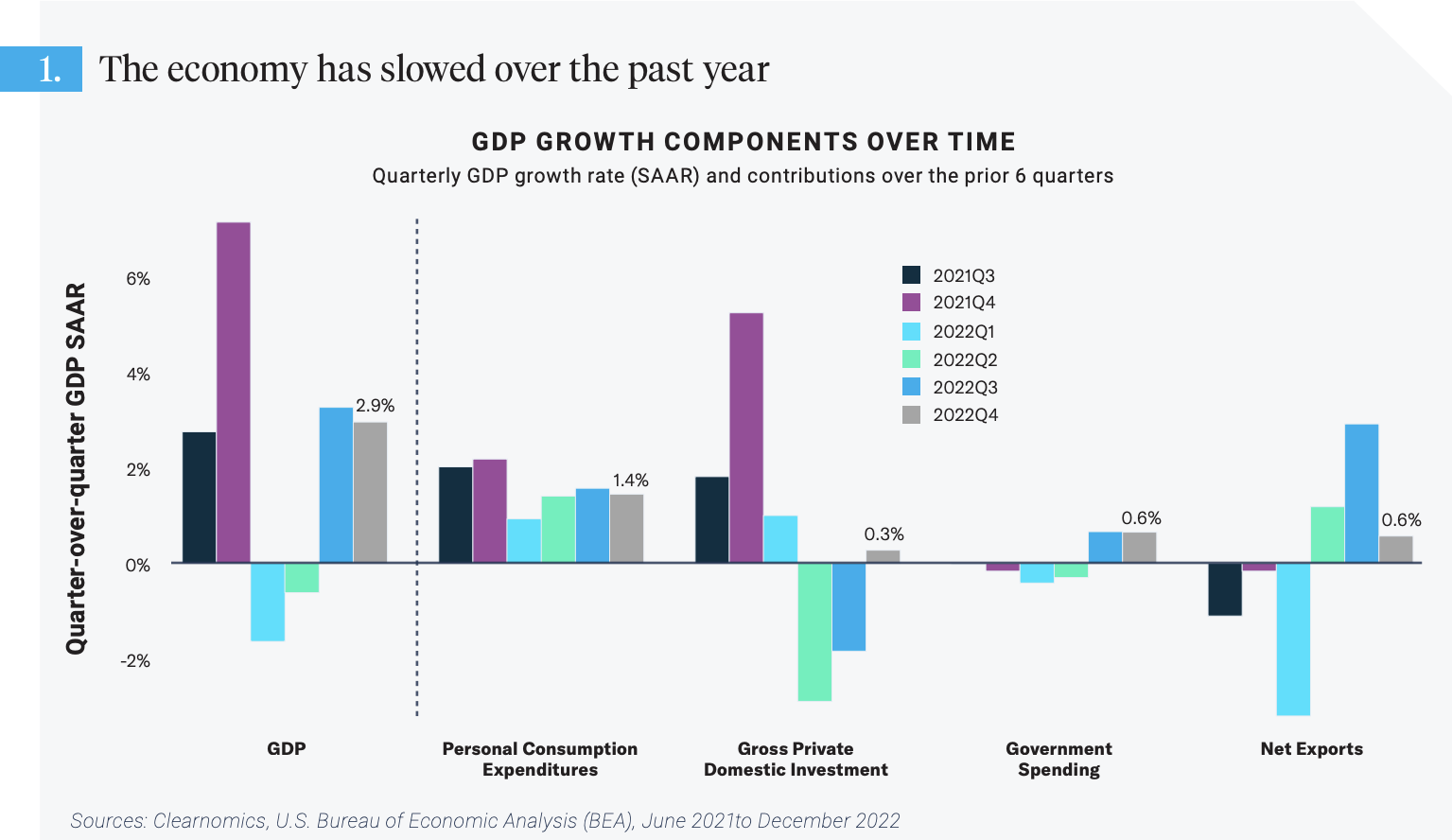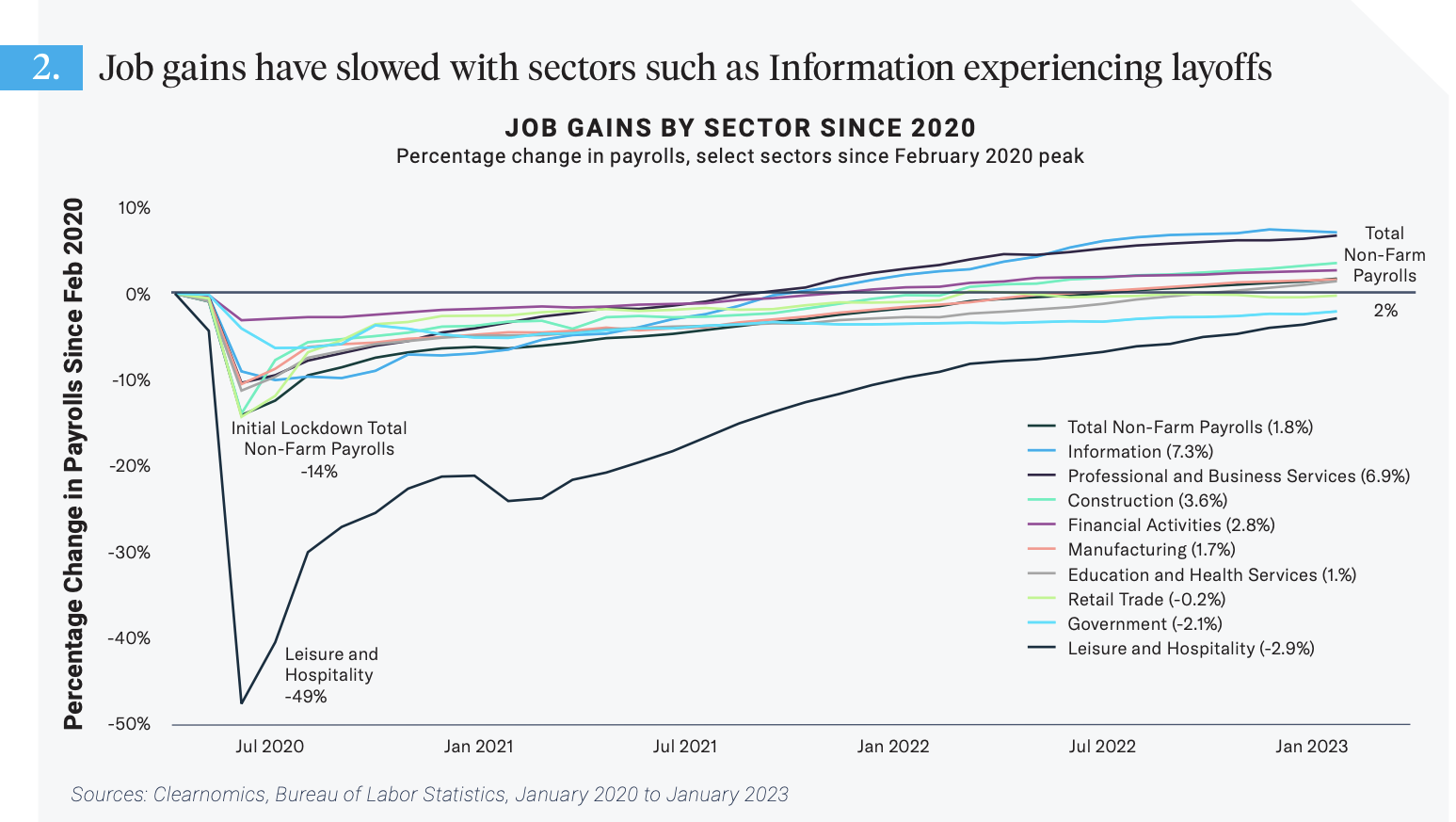
How Layoffs and Fed Rate Hikes Affect the Broader Economy
Layoff announcements are ramping up as companies adjust to slowing sales and profitability. So far, major job cuts have been concentrated in technology and consumer-related industries due to overhiring when demand was unusually strong during the pandemic recovery. Whether this spills into the broader economy is the subject of debate among investors and economists. With markets already expecting a mild recession in 2023, how should long-term investors maintain perspective on this topic over the next year?
There is no doubt that the economy has slowed from the rapid post-pandemic pace that fueled overexpansion by companies and, arguably, overconfidence. Recent Gross Domestic Product (GDP) data shows that the economy grew 2.1% in 2022 compared to 5.9% the year before. From a macroeconomic perspective, this is the result of the usual culprits that have dampened the mood of consumers and businesses: inflation and Federal Reserve (Fed) rate hikes. Similarly, consumer spending slowed at the end of last year, with retail sales figures declining 1.1% in December and personal consumption expenditures, which are adjusted for inflation, falling 0.1% in November and 0.2% in December.

Consumer spending both impacts the job market and is impacted by it. Strong consumer spending historically drives top-line revenue growth for businesses and creates incentives to expand. Technology and consumer sectors benefited from these trends over the past few years as households spent their pandemic savings and stimulus checks, while also taking on more debt. This fueled rapid hiring activity and led to record job openings and strong wage gains. In December, the average wage increase for hourly workers was about 5% from the year before – not better than inflation, but positive nonetheless.

The reversal of these trends as households reduce discretionary purchases, including on personal computers and home furnishings, is why these sectors are now experiencing layoffs. While layoffs are never pleasant for individuals or companies, investors need to maintain a broad perspective to best understand how they might affect markets. Whether these layoffs have a domino effect on the rest of the economy depends on whether they are only the result of overhiring in specific industries, or due to broader economic trends such as slowing growth and the Fed’s battle against inflation. There are a few key facts to keep in mind.
First, these layoffs which number in the hundreds of thousands, while large in isolation, are a drop in the bucket compared to the overall economy which added 4.5 million net new jobs in 2022, 6.7 million in 2021, and averaged 2.3 million each year in the decade leading up to the 2020 recession. Like the early 2000s tech bubble, the economic impact has been isolated so far, even if it’s had a large impact on specific sectors. In this sense, current layoffs represent a “white-collar recession.”
Second, while it’s still too soon to say for certain, there are signs that the rest of the economy can remain healthy. Although GDP slowed in 2022, growth was robust in the second half of the year. Inflation has been easing over this same period, increasing the likelihood that the Fed pauses its rate hikes later this year. And while many expect flat GDP growth in 2023, few expect anything worse than a mild recession.
Third, consumer confidence has suffered due to high prices but is now recovering. Whether this continues will depend largely on the debt loads that many households are facing amid higher mortgage rates and signs that delinquencies may be rising in areas such as auto and personal loans. Still, debt levels are nowhere near levels that led to the 2008 financial crisis.
Ultimately, recessions and layoffs are a natural part of the economic cycle. These are times when workers, especially those with advanced training and highly specialized skills, are re-allocated to where they are valued the most. Just as it has across history, we believe this sets the stage for future growth.

White-collar recession is the belief that white-collar office jobs are more at risk for uncertainty and layoffs during a potential recession, breaking the usual pattern leading into a downturn.
Carefully consider the Fund’s investment objectives, risk factors, charges, and expenses before investing. This and additional information can be found in Amplify Funds statutory and summary prospectus, which may be obtained above or by calling 855-267-3837, or by visiting AmplifyETFs.com. Read the prospectus carefully before investing.
Investing involves risk, including the possible loss of principal. Shares of any ETF are bought and sold at market price (not NAV), may trade at a discount or premium to NAV and are not individually redeemed from the Fund. Brokerage commissions will reduce returns. It is not possible to invest directly in an index.
Amplify ETFs are distributed by Foreside Fund Services, LLC.
Carefully consider the Funds’ investment objectives, risk factors, charges, and expenses before investing. This and additional information can be found in Amplify Funds statutory and summary prospectus, which may be obtained by calling 855-267-3837 or by visiting AmplifyETFs.com. Read the prospectus carefully before investing.
Investing involves risk, including the possible loss of principal. Shares of any ETF are bought and sold at market price (not NAV), may trade at a discount or premium to NAV and are not individually redeemed from the Fund. Brokerage commissions will reduce returns.
Amplify ETFs are distributed by Foreside Fund Services, LLC.


